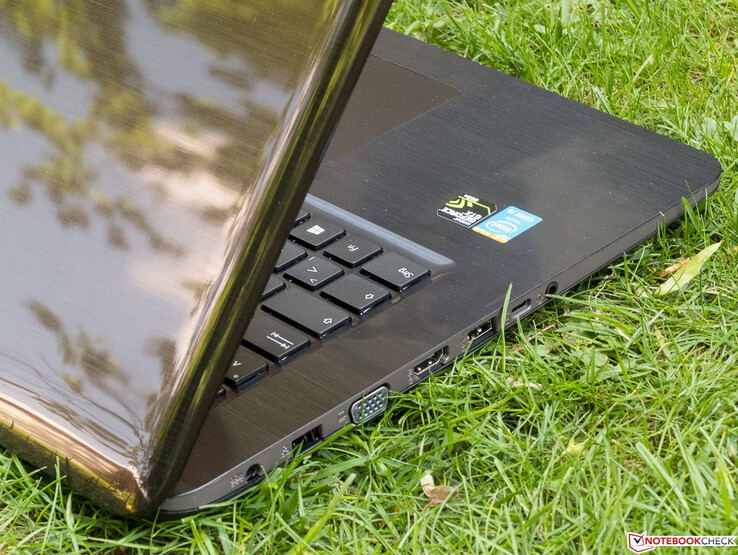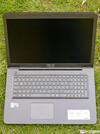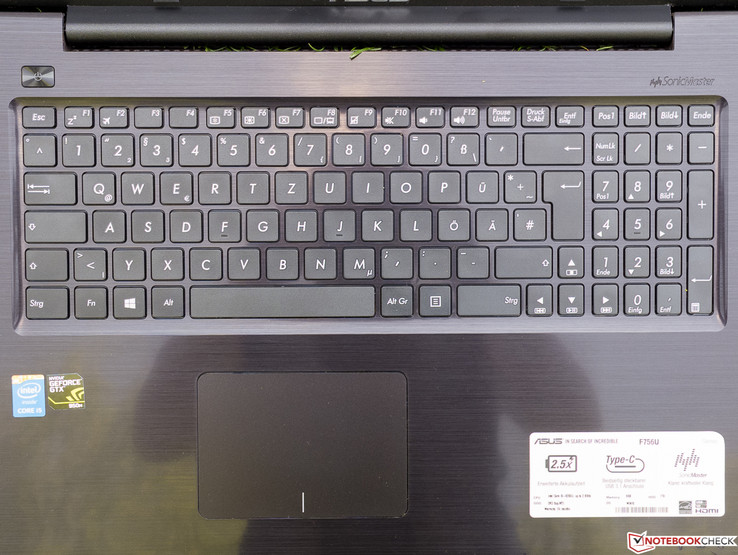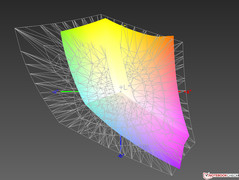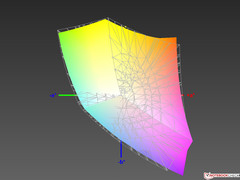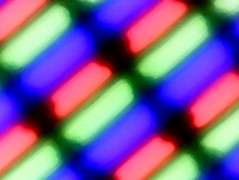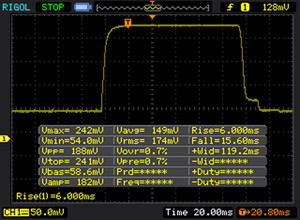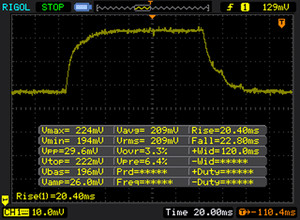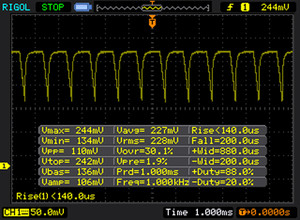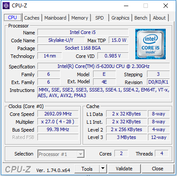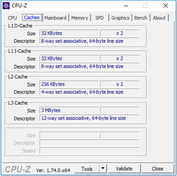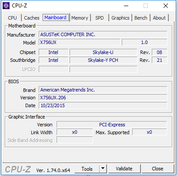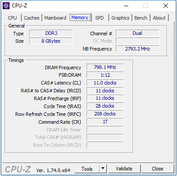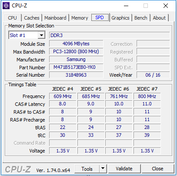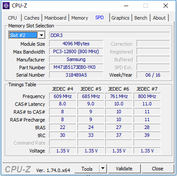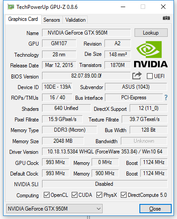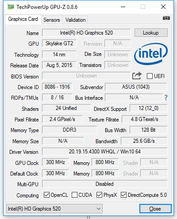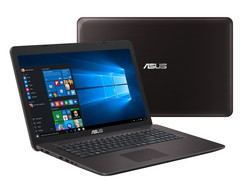Breve Análise do Portátil Asus F756UX-T7013T
Os Top 10
» Os Top 10 Portáteis Multimídia
» Os Top 10 Portáteis de Jogos
» Os Top 10 Portáteis Leves para Jogos
» Os Top 10 Portáteis Acessíveis de Escritório/Empresariais
» Os Top 10 Portáteis Premium de Escritório/Empresariais
» Os Top 10 dos Portáteis Workstation
» Os Top 10 Subportáteis
» Os Top 10 Ultrabooks
» Os Top 10 Conversíveis
» Os Top 10 Tablets
» Os Top 10 Smartphones
» A melhores Telas de Portáteis Analisadas Pela Notebookcheck
» Top 10 dos portáteis abaixo dos 500 Euros da Notebookcheck
» Top 10 dos Portáteis abaixo dos 300 Euros
| |||||||||||||||||||||||||
iluminação: 83 %
iluminação com acumulador: 265 cd/m²
Contraste: 1576:1 (Preto: 0.17 cd/m²)
ΔE ColorChecker Calman: 7.18 | ∀{0.5-29.43 Ø4.78}
ΔE Greyscale Calman: 7.97 | ∀{0.09-98 Ø5}
94% sRGB (Argyll 1.6.3 3D)
59% AdobeRGB 1998 (Argyll 1.6.3 3D)
64.6% AdobeRGB 1998 (Argyll 3D)
93.7% sRGB (Argyll 3D)
63.9% Display P3 (Argyll 3D)
Gamma: 2.34
CCT: 8541 K
| Asus F756UX-T7013T | Medion Erazer P7644 | HP ProBook 470 G3 | HP Pavilion 17-g120ng | |
|---|---|---|---|---|
| Display | -2% | 1% | 4% | |
| Display P3 Coverage (%) | 63.9 | 63.4 -1% | 65.1 2% | 65.7 3% |
| sRGB Coverage (%) | 93.7 | 90.3 -4% | 92 -2% | 97.6 4% |
| AdobeRGB 1998 Coverage (%) | 64.6 | 64.5 0% | 66.5 3% | 67.7 5% |
| Response Times | -43% | 2% | -93% | |
| Response Time Grey 50% / Grey 80% * (ms) | 42 ? | 48 ? -14% | 35 ? 17% | 70 ? -67% |
| Response Time Black / White * (ms) | 21 ? | 36 ? -71% | 24 ? -14% | 46 ? -119% |
| PWM Frequency (Hz) | 1000 ? | 50 ? | 200 ? | |
| Screen | -17% | 2% | 3% | |
| Brightness middle (cd/m²) | 268 | 296 10% | 314 17% | 309 15% |
| Brightness (cd/m²) | 255 | 280 10% | 291 14% | 292 15% |
| Brightness Distribution (%) | 83 | 87 5% | 88 6% | 86 4% |
| Black Level * (cd/m²) | 0.17 | 0.48 -182% | 0.32 -88% | 0.27 -59% |
| Contrast (:1) | 1576 | 617 -61% | 981 -38% | 1144 -27% |
| Colorchecker dE 2000 * | 7.18 | 4.71 34% | 3.43 52% | 4.53 37% |
| Colorchecker dE 2000 max. * | 11.67 | |||
| Greyscale dE 2000 * | 7.97 | 5.17 35% | 3.72 53% | 5.66 29% |
| Gamma | 2.34 94% | 2.33 94% | 2.39 92% | 2.62 84% |
| CCT | 8541 76% | 7613 85% | 6764 96% | 7893 82% |
| Color Space (Percent of AdobeRGB 1998) (%) | 59 | 59 0% | 59.8 1% | 62 5% |
| Color Space (Percent of sRGB) (%) | 94 | 90 -4% | 92 -2% | 98 4% |
| Média Total (Programa/Configurações) | -21% /
-17% | 2% /
2% | -29% /
-11% |
* ... menor é melhor
Exibir tempos de resposta
| ↔ Tempo de resposta preto para branco | ||
|---|---|---|
| 21 ms ... ascensão ↗ e queda ↘ combinadas | ↗ 6 ms ascensão | |
| ↘ 15 ms queda | ||
| A tela mostra boas taxas de resposta em nossos testes, mas pode ser muito lenta para jogadores competitivos. Em comparação, todos os dispositivos testados variam de 0.1 (mínimo) a 240 (máximo) ms. » 45 % de todos os dispositivos são melhores. Isso significa que o tempo de resposta medido é semelhante à média de todos os dispositivos testados (20.2 ms). | ||
| ↔ Tempo de resposta 50% cinza a 80% cinza | ||
| 42 ms ... ascensão ↗ e queda ↘ combinadas | ↗ 20 ms ascensão | |
| ↘ 22 ms queda | ||
| A tela mostra taxas de resposta lentas em nossos testes e será insatisfatória para os jogadores. Em comparação, todos os dispositivos testados variam de 0.165 (mínimo) a 636 (máximo) ms. » 66 % de todos os dispositivos são melhores. Isso significa que o tempo de resposta medido é pior que a média de todos os dispositivos testados (31.6 ms). | ||
Cintilação da tela / PWM (modulação por largura de pulso)
| Tela tremeluzindo/PWM detectado | 1000 Hz | ≤ 90 % configuração de brilho | |
A luz de fundo da tela pisca em 1000 Hz (pior caso, por exemplo, utilizando PWM) Cintilação detectada em uma configuração de brilho de 90 % e abaixo. Não deve haver cintilação ou PWM acima desta configuração de brilho. A frequência de 1000 Hz é bastante alta, então a maioria dos usuários sensíveis ao PWM não deve notar nenhuma oscilação. [pwm_comparison] Em comparação: 53 % de todos os dispositivos testados não usam PWM para escurecer a tela. Se PWM foi detectado, uma média de 8111 (mínimo: 5 - máximo: 343500) Hz foi medida. | |||
| Cinebench R15 | |
| CPU Multi 64Bit | |
| HP ProBook 470 G3 | |
| Medion Erazer P7644 | |
| HP Pavilion 17-g120ng | |
| Asus F756UX-T7013T | |
| CPU Single 64Bit | |
| HP ProBook 470 G3 | |
| Medion Erazer P7644 | |
| HP Pavilion 17-g120ng | |
| Asus F756UX-T7013T | |
| PCMark 8 | |
| Home Score Accelerated v2 | |
| Acer Aspire V Nitro Black Edition VN7-792G-74Q4 | |
| HP ProBook 470 G3 | |
| Medion Erazer P7644 | |
| Asus F756UX-T7013T | |
| Work Score Accelerated v2 | |
| Acer Aspire V Nitro Black Edition VN7-792G-74Q4 | |
| Medion Erazer P7644 | |
| HP ProBook 470 G3 | |
| Asus F756UX-T7013T | |
| PCMark 8 Home Score Accelerated v2 | 3162 pontos | |
| PCMark 8 Work Score Accelerated v2 | 3969 pontos | |
Ajuda | ||
| Asus F756UX-T7013T HGST Travelstar 5K1000 HTS541010A9E680 | Medion Erazer P7644 Phison 256GB PC3110-S10C | HP ProBook 470 G3 WDC Scorpio Blue WD10JPVX-75JC3T0 | HP Pavilion 17-g120ng Toshiba MQ01ABD100 | |
|---|---|---|---|---|
| CrystalDiskMark 3.0 | 15221% | 16% | -10% | |
| Read Seq (MB/s) | 105.8 | 511 383% | 111.4 5% | 104.6 -1% |
| Read 4k (MB/s) | 0.413 | 32.35 7733% | 0.434 5% | 0.358 -13% |
| Read 4k QD32 (MB/s) | 0.812 | 305.7 37548% | 1.126 39% | 0.679 -16% |
| 3DMark 11 - 1280x720 Performance GPU | |
| Acer Aspire V Nitro Black Edition VN7-792G-74Q4 | |
| Medion Erazer P7644 | |
| Asus F756UX-T7013T | |
| HP Pavilion 17-g120ng | |
| HP ProBook 470 G3 | |
| 3DMark 11 Performance | 3846 pontos | |
| 3DMark Cloud Gate Standard Score | 8906 pontos | |
| 3DMark Fire Strike Score | 2541 pontos | |
Ajuda | ||
| baixo | média | alto | ultra | |
|---|---|---|---|---|
| BioShock Infinite (2013) | 122 | 82.8 | 69.7 | 24.9 |
| The Witcher 3 (2015) | 55.1 | 33 | 17.5 | |
| XCOM 2 (2016) | 50.2 | 19.8 | 13.3 | |
| The Division (2016) | 50.3 | 37 | 18 | 13.6 |
| Hitman 2016 (2016) | 38.2 | 34.6 | 20.9 | 19.7 |
Barulho
| Ocioso |
| 32.4 / 32.6 / 32.6 dB |
| HDD |
| 32.7 dB |
| DVD |
| 37.4 / dB |
| Carga |
| 42 / 45.2 dB |
 | ||
30 dB silencioso 40 dB(A) audível 50 dB(A) ruidosamente alto |
||
min: | ||
(±) A temperatura máxima no lado superior é 42 °C / 108 F, em comparação com a média de 36.9 °C / 98 F , variando de 21.1 a 71 °C para a classe Multimedia.
(-) A parte inferior aquece até um máximo de 50.5 °C / 123 F, em comparação com a média de 39.2 °C / 103 F
(+) Em uso inativo, a temperatura média para o lado superior é 25 °C / 77 F, em comparação com a média do dispositivo de 31.3 °C / ### class_avg_f### F.
(+) Os apoios para as mãos e o touchpad são mais frios que a temperatura da pele, com um máximo de 29.9 °C / 85.8 F e, portanto, são frios ao toque.
(±) A temperatura média da área do apoio para as mãos de dispositivos semelhantes foi 28.7 °C / 83.7 F (-1.2 °C / -2.1 F).
| desligado | |
| Ocioso | |
| Carga |
|
Key:
min: | |
| Asus F756UX-T7013T | Medion Erazer P7644 | HP ProBook 470 G3 | HP Pavilion 17-g120ng | |
|---|---|---|---|---|
| Duração da bateria | 33% | 12% | 19% | |
| Reader / Idle (h) | 8.2 | 8.2 0% | ||
| WiFi v1.3 (h) | 3.6 | 4.8 33% | 4.6 28% | 4.3 19% |
| Load (h) | 1.3 | 1.4 8% | ||
| H.264 (h) | 4.5 |
Pro
Contra
O visual do robusto substituto de desktop com uma duração de bateria relativamente curta certamente atrairá os fanáticos das superfícies brilhantes. Ele possui uma bela tela com contraste extremamente alto para esta faixa de preços, e ela não apresenta desvantagens técnicas.
O comprador provavelmente obterá um pouco mais do que pode se esperar por um preço relativamente baixo de 770 Euros com o Asus F756UX-T7013T.
O teclado somente é condicionalmente adequado para a digitação. A carcaça deixa uma impressão um pouco instável em alguns lugares, que não serão notadas ao usá-lo sobre uma mesa. Apenas o mínimo está presente, em termos de interfaces e tecnologias sem fio, além do VGA e USB Type-C. O módulo WiFi é decepcionante, e será um claro critério para a exclusão para muitos usuários de 5 GHz.
Por isso, o F756UX é bem adequado para gamers com um orçamento e fanáticos da multimídia. Quem achar convincente o conceito básico do aparelho, também poderia optar pelo modelo SSD, mais caro. Nós não vemos um valor agregado relevante no i7-6500U opcional, dado que a placa de vídeo sempre será o gargalo do desempenho, inclusive com o i7. Todos nossos oponentes no teste atingem avaliações marginalmente superiores de 80 e 81 %, mas suas configurações testadas também são mais caras.
Esta é uma versão reduzida da análise original. Você pode ler a análise completa em inglês aqui.
Asus F756UX-T7013T
- 05/12/2016 v5.1 (old)
Sven Kloevekorn




